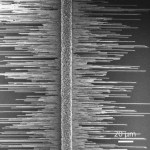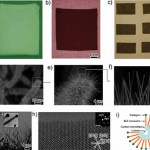Nanowires
Since the haiku post was well received, and since we have another three pieces online today – each on a different finding and each interesting in its own right – I have decided to return to the haiku format. Among other things, there is something quite satisfying about distilling complex scientific findings down to 17 little syllables – like writing the perfect tweet, but more so.
In any case, follow the links to read more:
A burst of enzymes:
A transcription traffic jam
Watch for gene speed bumps
Genetics can rid
The poison from potatoes
Or add it elsewhere
image: Thinkstock…
A recent study by Prof. Ernesto Joselevich and his team, published in Science, features perfectly aligned horizontal arrays of thin, millimeter-long nanowires. We spoke with Joselevich recently to find out why he and others in the field are excited by this advance:
WSW: Your lab has produced a fair amount of innovative research in recent years. Why is this one special?
EJ: First of all, we succeeded in growing very long horizontal nanowires with exquisite control over their orientation. Because of the numerous potential uses for semiconductor nanowires, there is a lot of competition to…
While it might sound science fiction or comic book fodder, scientists have actually developed a kind of wearable protective cloth from T-shirts that contains the same ultra-strong material used to armor tanks.
Modern high-impact military vehicles and bulletproof vests are reinforced with a substance called boron carbide. It's the third hardest material known to man at room temperature, with a hardness of 9.3 on the mohs scale, just a hair behind diamond's hardness of 10. It's hard to imagine how such a rigid material could be comfortable to wear, but scientists have recently developed the…


